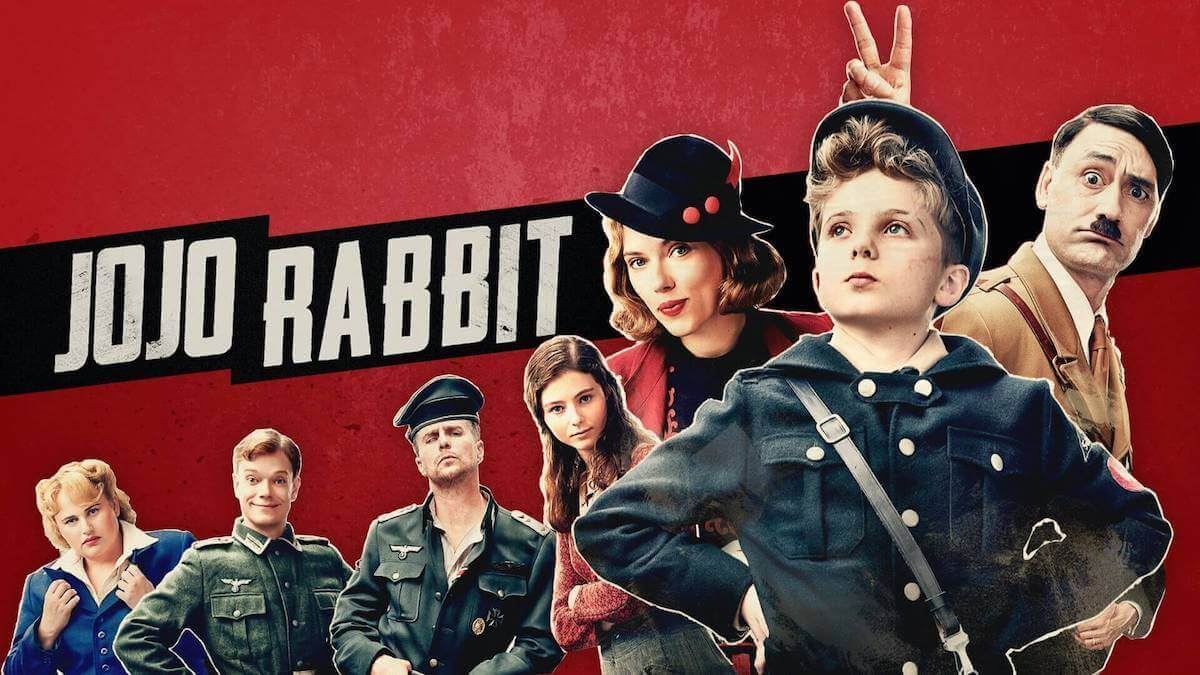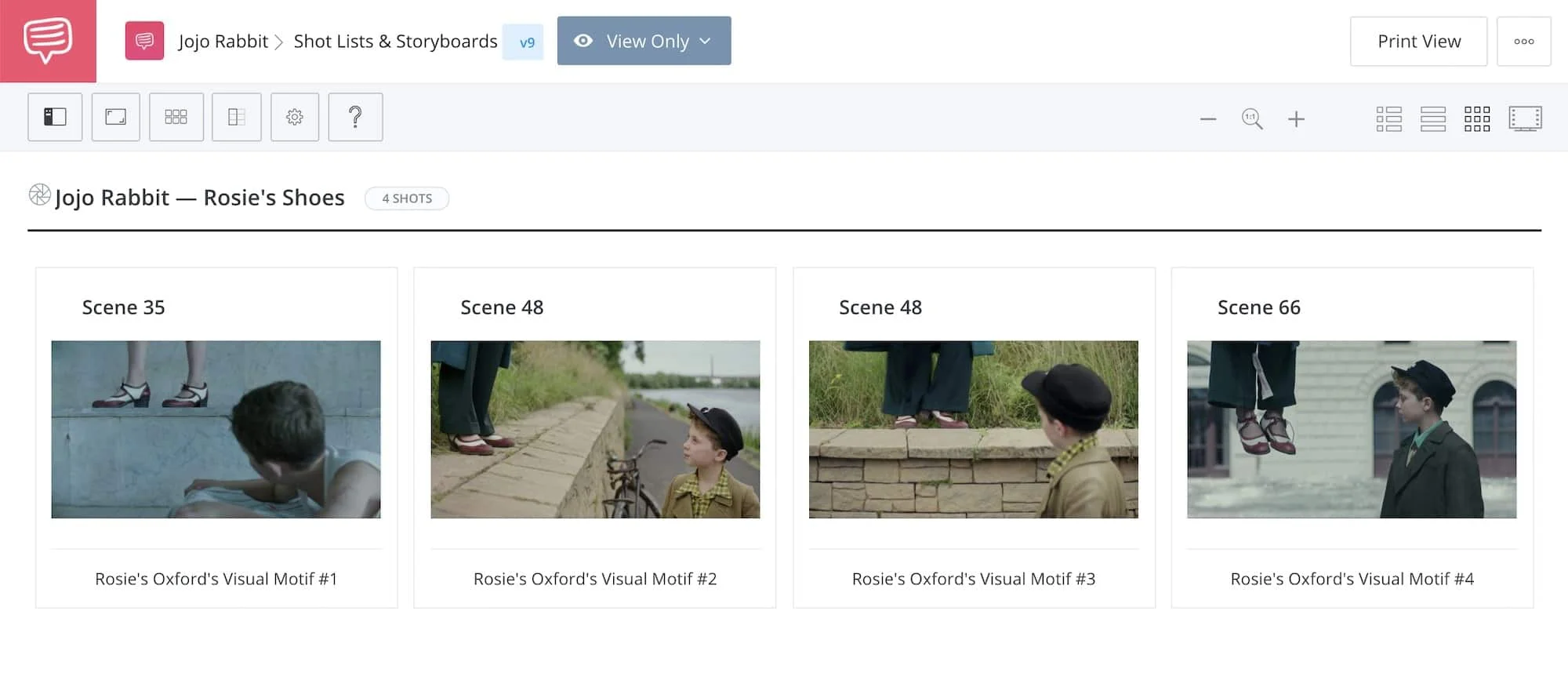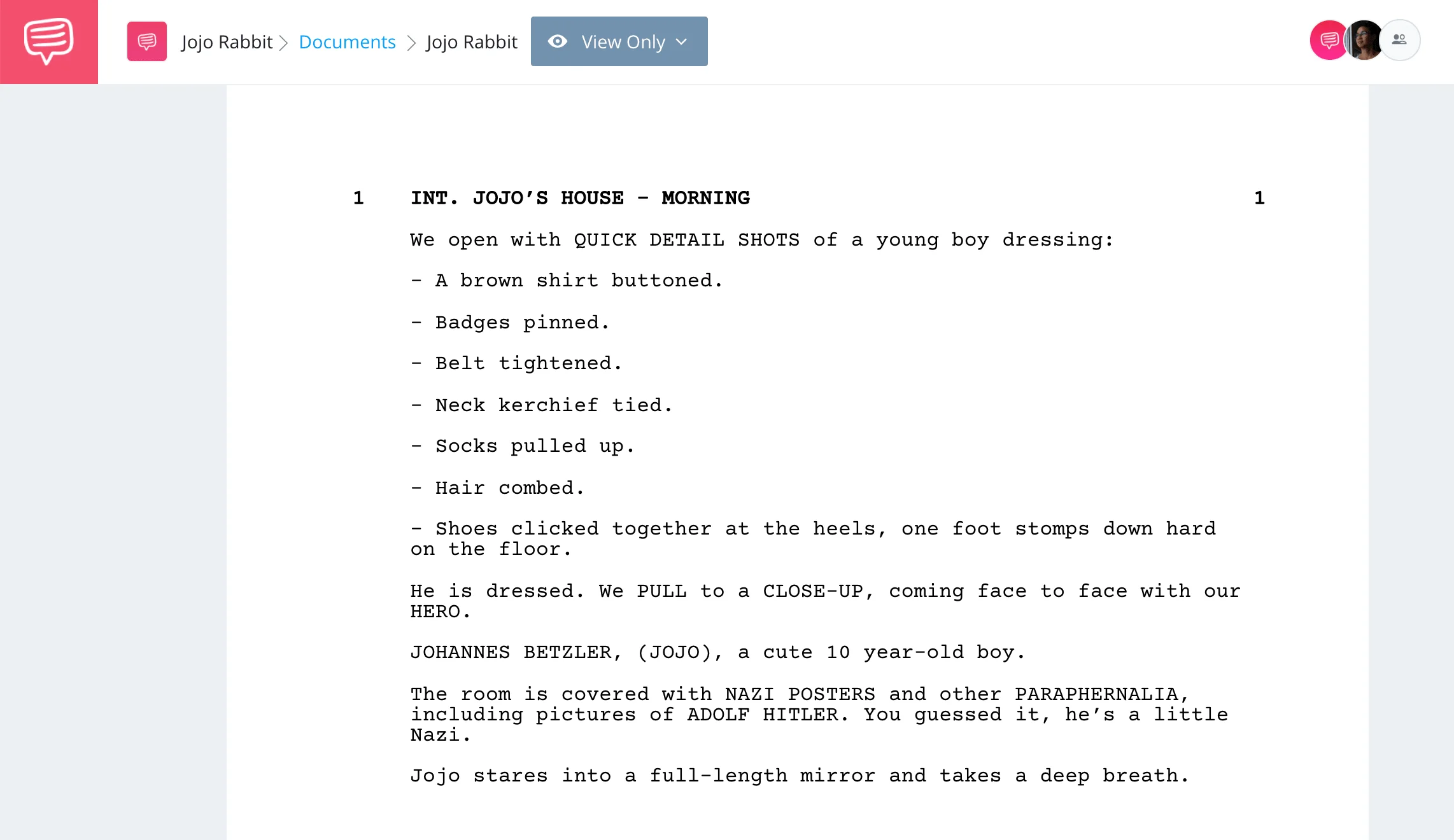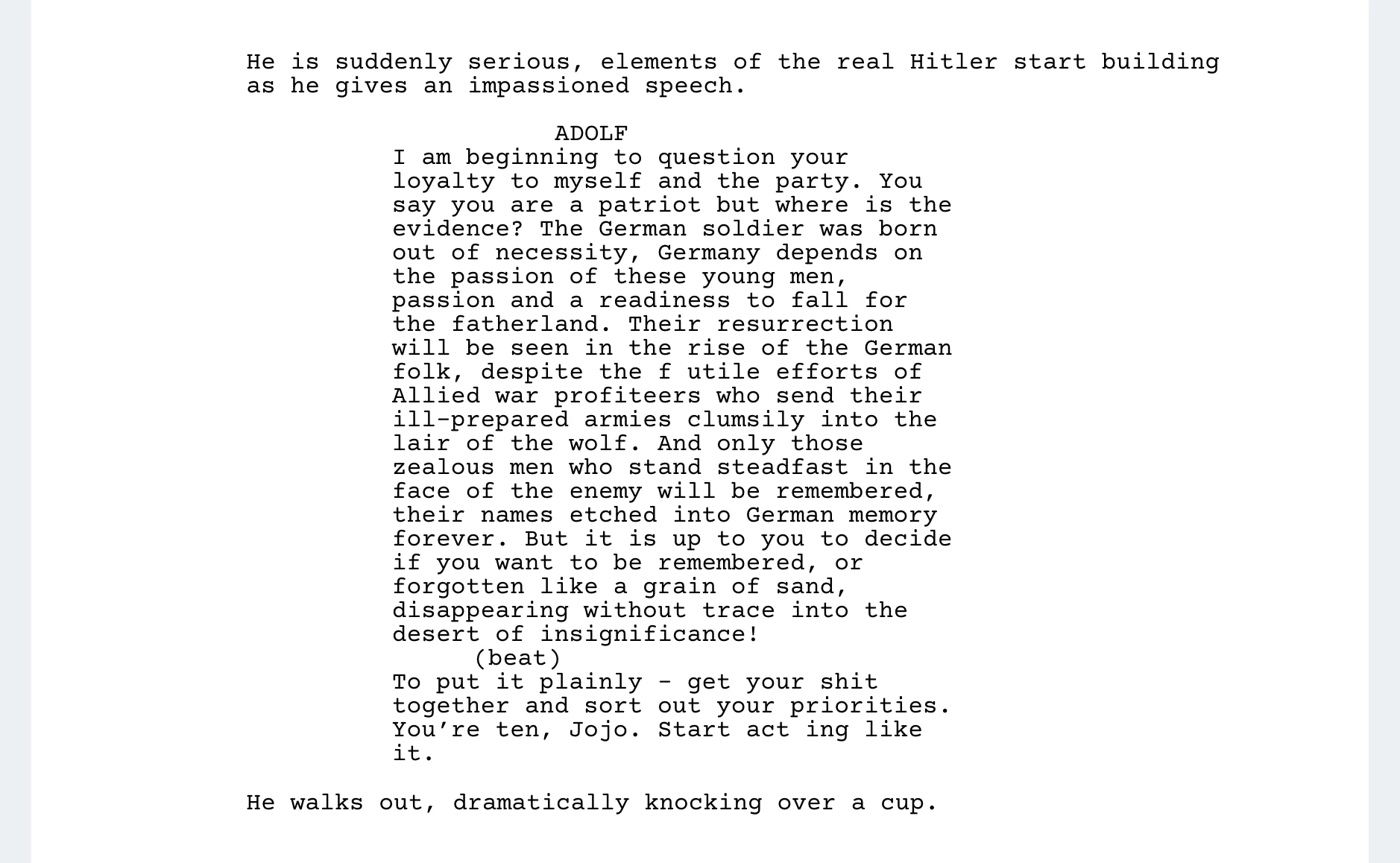Director Taika Waititi’s Jojo Rabbit was the anti-hate satire that many felt was needed at this precise point in history. Modern-day intolerance was challenged through the lens of a period piece comedy with a big heart. What is Jojo Rabbit about? We’ll start with a synopsis before jumping into our Jojo Rabbit analysis and how Waititi set us up for the ultimate emotional gut-punch. SPOILER ALERT!
Jojo Rabbit Synopsis
What is Jojo Rabbit about?
Jojo Rabbit follows a 10-year-old boy named Johannes Betzler, an idealistic yet misguided Hitler Youth during WWII. He lives with his mother, Rosie, and is often visited by an imaginary friend — a cartoonish version of Adolf Hitler.
While attending Hitler Youth Training Camp, Jojo is injured while mishandling a grenade. While recovering from his injuries, Jojo discovers that his mother has been secretly hiding a young Jewish girl named Elsa in their attic.
Jojo is now stuck — revealing this hideaway to the authorities would get both he and his mother executed. Instead, his plan is to learn as much as he can about Jews so he can provide this intel to his superiors.
This plan backfires when his conversations reveal Elsa to be anything but the evil monster he assumed she was. For more on the plot, tone and satire at work in Jojo Rabbit, here's the trailer.
Jojo Rabbit Director
How Taika Waititi uses motifs
Jojo Rabbit director Taika Waititi is no stranger to the motif. He has been crafting and implementing compelling motifs in film since all the way back in his TV days, working on episodes of the excellent 2007 HBO show Flight of the Conchords.
MOTIF DEFINITION
What is a motif in film?
A motif is a repeated narrative element that supports the theme of a story. A motif in film can be presented in a number of ways like physical items, sound design, lines of dialogue, music, colors, and symbols. Any motif used will vastly improve your story if it has narrative significance.
Visual motifs in film use recurring patterns through props, set design, costumes, symbols, and events to support the intended theme of a story.
Examples of motifs in film:
- The American flag in Silence of the Lambs
- Mirrors in Black Swan
- The color red in The Sixth Sense
- Clocks in Back to the Future
In Jojo Rabbit, Waititi uses motifs for one purpose — to make the most emotional scene in the movie like a punch to the gut. We've seen these motifs throughout the film but we aren't quite sure of their significance until the most devastating moment...
SPOILER ALERT!
Jojo's mother is hanged for treason.
As we break down the Jojo Rabbit hanging scene, you’ll find that there are two important visual motifs at play in the hanging scene: the butterflies and the mother’s shoes.
To see these repeated visuals clearly for our Jojo Rabbit analysis we’ll bring the scene into a StudioBinder storyboard. First, let's look at our first motif — butterflies.
Jojo Rabbit • Storyboard of butterfly shots • View Storyboard
Earlier on in Jojo Rabbit, Waititi introduced butterflies as an important image. A particular feeling and emotion have been attached to the symbol, which sets us up even more for the emotional gut-punch to come after Jojo follows a particular blue butterfly.
More striking than the butterfly imagery, is the mother’s distinctive pair of shoes — the second important visual motif.
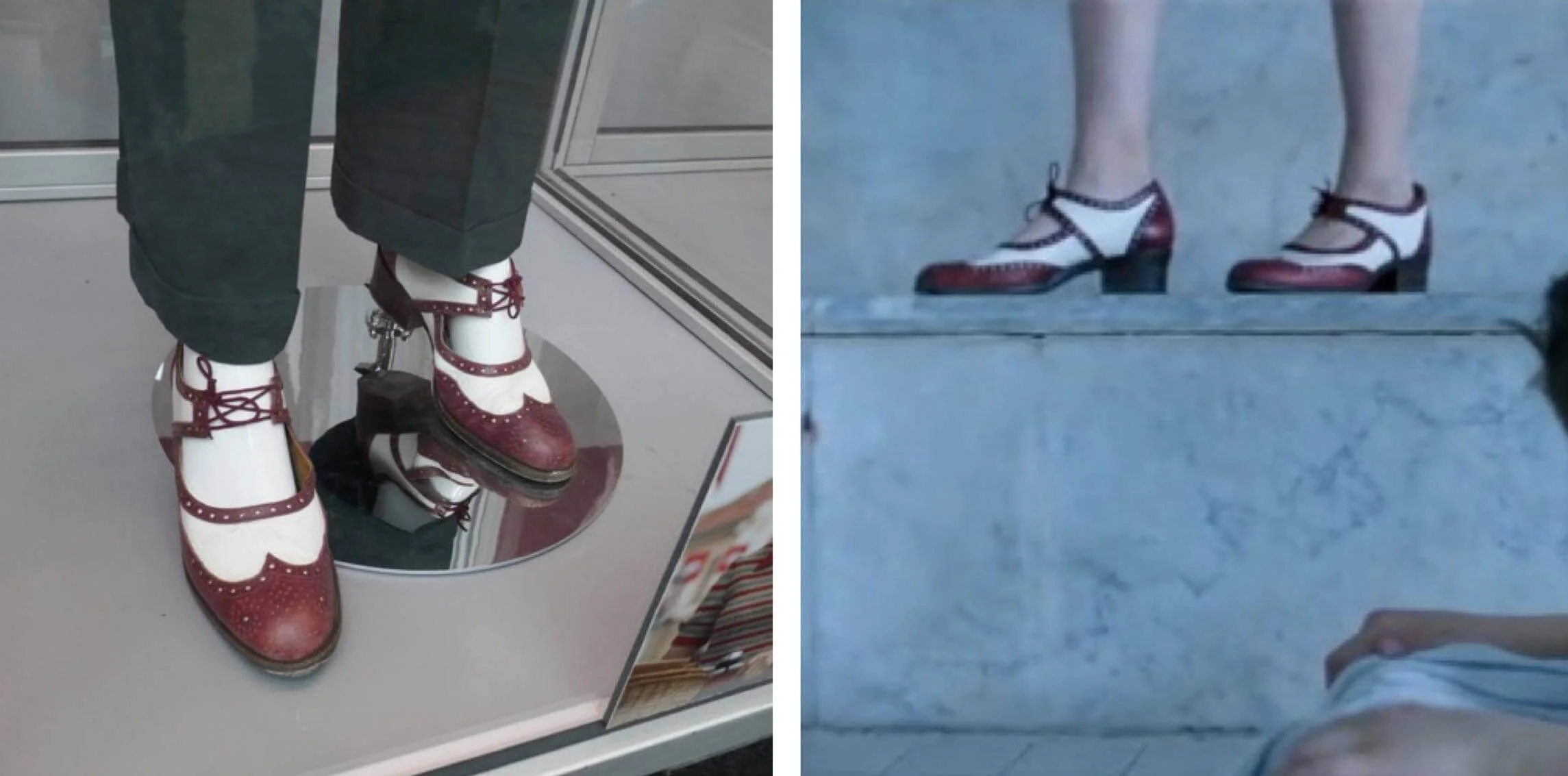
Rosie's Shoes
Even the simplest Jojo Rabbit analysis reveals these shoes to hold tremendous significance. The mother’s shoes had great importance placed on them right from the Jojo Rabbit script. This pair of shoes is all we need to see in order to register the horrible truth of Rosie’s death by hanging at the gallows.
Setups and payoffs are an intrinsic part of writing. The best setups don’t feel like setups while they’re happening, and Jojo Rabbit director Taika Waititi constructs this particular setup masterfully. He has repeatedly shown us these shoes in this particular framing in lighthearted contexts, so that the image of her hanging, dead, hits us extra hard.
Jojo Rabbit • Rosie’s shoes • View Storyboard
A good director thinks about the composition of every single shot in their film. They know, for example, the rules of composition — when to follow them and when to break them.
Waititi used a very particular and odd compositional motif. You may have even registered their oddness while watching the film but their purpose isn't revealed until the critical moment. That's how a great director plans and executes a visual motif.
Jojo Rabbit analysis
How to shift tone
For the next stage of our Jojo Rabbit analysis, we’re turning our attention to the complex matter of shifting tone. An abrupt change of tone can instantly break a viewer’s immersion and take them out of the film. Navigating a tonal shift takes careful planning at all levels, starting with the Jojo Rabbit script.
Waititi chose satire as the ideal vehicle to shape his message. Specifically, the film falls under a type called Menippean satire, which we explain in this video.
3 Types of Satire Explained • Subscribe on YouTube
The difference in tone between the hanging scene and every scene that preceded it is immediately apparent when endeavoring any Jojo Rabbit analysis. Let’s use StudioBinder's screenwriting software to take a look at the Jojo Rabbit script for closer inspection.
Jojo Rabbit Screenplay • Read Full Script
The first indication of the tonal shift in the script comes from this action line which sees Jojo’s imaginary friend manifestation of Hitler losing his friendly, comedic edge. Without removing the element of comedy, the real hate of Hitler’s messaging is beginning to show, tipping to the tone toward the more serious end of the spectrum.
Jojo Rabbit Screenplay • Tonal Shift • Read Full Scene
On the visual side, the Jojo Rabbit director strips all of the bright, warm colors out of the image, replacing them with cold, blue tones. For more information on these types of color decisions in post, make sure you understand the difference between color grading vs. color correction.
The shocking reveal is accompanied by a large slow down of pace. Shots linger on Jojo’s heartbreak and the passage of time is elongated through slow edits.
Tone can be reinforced or magnified through composition. A tonal shift is a great chance to change up the visual style of a film, and Taika Waititi does that in Jojo Rabbit by withholding visual information.
Did You Know?
The Jojo Rabbit script was based on the novel ‘Caging Skies.’ The book, written by Christine Leunens, is far darker in tone and ends in a much different manner than the film.
TAIKA WAITITI
How to withhold information
For the final stage of our Jojo Rabbit analysis, we’re focusing on the things that the film’s director chose not to show. The majority of a film’s impact on an audience comes from the visual information that it conveys, but, occasionally, withholding visual information can serve to heighten an emotional moment.
In this scene, the director of Jojo Rabbit chose not to show Rosie’s face. We know who it is instantly because her striking red and white shoes have been set up perfectly throughout the course of the film. Not allowing us as an audience to see her face is a bold choice; one that adds an extra layer of closeness between Jojo and his mother that the audience doesn’t get to share.
Did You Know?
Jojo Rabbit director Taika Waititi planned on using David Bowie’s Heroes as the closing song from the very beginning of his creative process.
When asked about shooting the scene this way, Taika Waititi explained that seeing a dead loved one is an intimate thing and that the audience doesn’t have permission to see what Jojo sees at that moment.
This use of visual and narrative motifs is just the beginning of what makes this such a powerful film. To get into even more detail on the visual style of the film, here’s Mihai Malaimare Jr., cinematographer of Jojo Rabbit, explaining the camera and lighting choices that were made.
For any filmmakers looking to add layers of meaning and symbolism to their next project, look to Taika Waititi and Jojo Rabbit for inspiration. As you can see, it doesn't require a lot to use motifs to create powerful and dramatic moments. A little planning in the screenplay and storyboarding, and that's all it takes.
Related Posts
UP NEXT
Arrival Explained
If you enjoyed this Jojo Rabbit analysis, you’re sure to like the other posts and videos in our Director’s Playbook series. Check out this breakdown of a scene from Denis Villeneuve’s Arrival and how he was able to use shot compositions and camera angles to tread the fine line between intrigue and fear.
Up Next: Arrival Explained →
Showcase your vision with elegant shot lists and storyboards.
Create robust and customizable shot lists. Upload images to make storyboards and slideshows.
